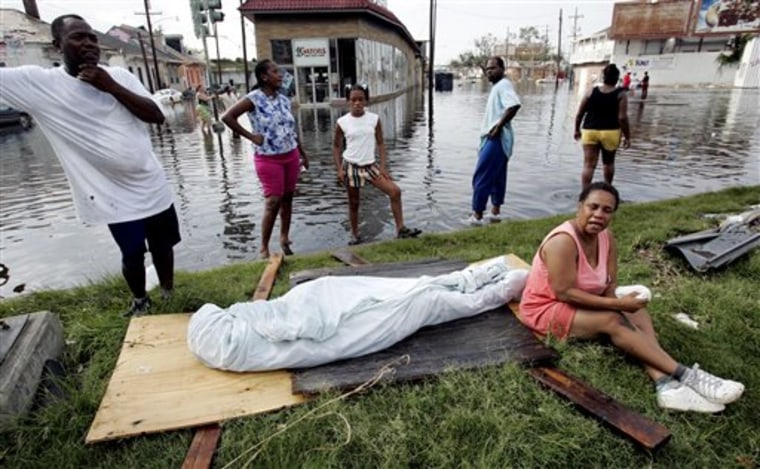Katrina. For most Americans, it needs no qualifiers.
Just as we hear the word "Vietnam" and think first of war, someone says "Katrina," and we think, not of a woman, but of broken levees and broken promises. Of property, lives and innocence lost.
The name conjures images of desperate, half-naked people waving white flags from rooftop islands emblazoned with pleas of "SOS." and "HELP US."
Of sweaty, hunger-crazed mobs swarming as soldiers push cartons of food and water from hovering helicopters.
Of bloated corpses, left to rot in the sun and be gnawed on by stray dogs.
Things like that don't happen here, we told ourselves. In the Third World, yes, but not in the United States.
That was before Aug. 29, 2005. Before Katrina.
At an estimated $81 billion in property damage, it is the costliest natural disaster in U.S. history. But to many, especially to those in greater New Orleans, this catastrophe was anything but an act of God.
A river not tamed
Residents on the Mississippi and Alabama coasts knew they were exposed to storms in the Gulf of Mexico, and that they built near the beaches at their own risk. But the people of New Orleans thought they were safe behind their network of earthen levees and concrete floodwalls.
By armoring and raising its banks, we had "tamed" the Mississippi River. But in the process, we starved of silt the delta marshlands that buffered the mainland from the Gulf of Mexico.
For years, experts had worried that a direct hit by a major hurricane would swamp the largely below-sea-level city. In the end, it didn't even take that.
As Katrina grew into a Category 5 monster, New Orleans Mayor C. Ray Nagin, calling it the "storm that most of us have long feared," ordered the city's first-ever mandatory evacuation. But in the last hours, the storm weakened to a Category 3 and veered east, striking the city a mere glancing blow.
To those of us who'd waited it out in the French Quarter or at the Superdome, Katrina seemed at first to have been just another "shoo-shoo" — a firecracker that fizzles, then goes out.
Then the water began to rise.
Defenses fail
What we didn't know was that overflow from Lake Pontchartrain to the north was battering the floodwalls on the 17th Street and London Avenue Canals. To the southeast, wind-driven storm surge funneled up the 76-mile Mississippi River-Gulf Outlet — the "Mr. Go" — was overtopping and eroding the city's outer defenses.
Within hours, 80 percent of New Orleans and nearly all of neighboring St. Bernard Parish were inundated.
Many of the storm's 1,600 victims — among them, 35 who drowned in their beds and wheelchairs at St. Rita's Nursing Home in St. Bernard Parish — died in the first violent rush of water. Others, like the 45 whose bodies were found in the chapel at New Orleans' Memorial Medical Center, languished for days in as they waited in vain for rescue.
Angry residents immediately blamed the Corps of Engineers for the levee failures. But as days passed, their anger turned to the Federal Emergency Management Agency.
In the days immediately following the storm, House Speaker Dennis Hastert questioned the sense of spending billions to rebuild a city, much of which was seven feet below sea level. "It looks like a lot of that place could be bulldozed," he said.
But such decisions are largely political and emotional, not practical or logical. And, for better or worse, we have chosen to rebuild New Orleans' flood protections around the city's pre-Katrina footprint.
Many return
The city has regained 77 percent of its population and commercial activity, and job figures are at 71 percent of pre-Katrina levels, according to a recent report by GCR & Associates, a local consulting firm. Tax credits and other programs have helped in the rebuilding of nearly 70,000 housing units, and the government has spent $15 billion on improved hurricane protection for the region.
But the storm has left more than 40,000 vacant homes or empty lots in New Orleans. Meanwhile, rents in the city are 50 percent higher than before Katrina.
We have tried to learn from Katrina.
When Hurricane Gustav threatened the city in September 2008, authorities backed the evacuation order with an armada of buses, and most heeded the warning. Earlier this year, the Mr. Go was closed to shipping.
The Corps assures residents the city's flood protections are stronger than ever. But the old defenses were supposed to have been strong enough to withstand the diminished Katrina that brushed by New Orleans.
Katrina left us in doubt, exposing the fallacy that with technology and tenacity, we can anticipate and meet every contingency. If the storm taught us anything, it's that nature, like evil, can never really be tamed.
___
Allen G. Breed, an AP national writer based in Raleigh, N.C., covered Katrina and its aftermath.
